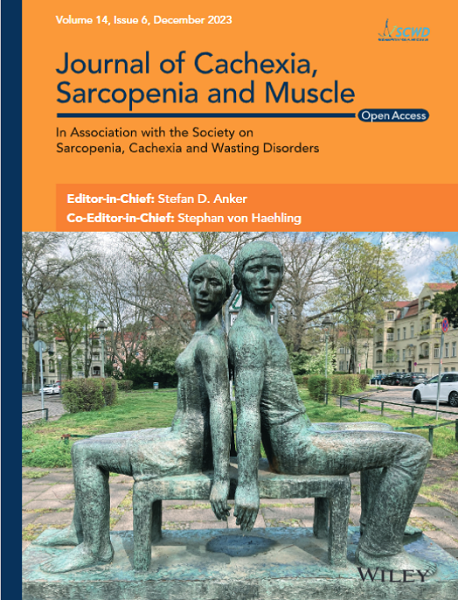Changes in Protein Metabolism and Early Development of Sarcopenia in Mice With Cholestatic Liver Disease
Abstract
Background
Sarcopenia is a frequent complication of liver cirrhosis. Here, we chose a mouse model of cholestatic liver disease (CLD) to gain mechanistic insights into the development of sarcopenia from the earliest stages of chronic liver injury. Particular attention was paid to protein metabolism, metabolite profiles, and mediators of CLD-induced muscle wasting.
Methods
Male C57BL/6 J mice underwent bile duct ligation (BDL), sham surgery, or served as untreated controls. The observation phase lasted from the preoperative stage to postoperative day 14. Metabolic cage experiments were performed to determine the nitrogen balance (N-BAL), nitrogen metabolite profiles, and total energy expenditure (TEE) using doubly labelled water. The fractional protein synthesis rate (FPSR) was assessed using 2H5-ring-phenylalanine. Plasma concentrations of inflammatory markers, metabolites, and enzymes associated with liver damage were investigated. Muscle strength and volume were assessed using a grip strength meter and MRI, respectively. Gene expression was analysed by real-time PCR.
Results
BDL caused CLD with necroses and inflammation, increased bilirubin (p < 0.0001) and conjugated bile acids (p < 0.05), and reduced food intake (p < 0.0001) and body weight (p < 0.0001; each vs. sham). Compared to controls, BDL mice showed lower N-BAL (p < 0.05), reduced TEE (p < 0.01), and lower FPSR in the liver (p < 0.05) and quadriceps muscle (p < 0.001). Arginine was the only plasma amino acid that was diminished after BDL compared to controls and sham treatment (p < 0.0001). Reduced muscle strength was observed as early as d3/d4 after BDL (p < 0.001; vs. sham), while muscle volume decreased from d6 to d13 (p < 0.05). In quadriceps muscle, a lower nuclei-to-fibre ratio (p < 0.001) and elevated 1-methyl-histidine (1-MH) (p < 0.001) were detected, whereas 3-MH was increased in the urine of BDL mice (p < 0.001; each vs. sham). The quadriceps muscle of BDL mice contained higher mRNA levels of atrophy-associated genes (Trim63: p < 0.0001, Fbxo32: p < 0.01) and Mstn (p < 0.05), but lower levels of genes involved in mitochondrial function (Cpt-1b: p < 0.05, Pgc-1α: p < 0.01; each vs. sham). In the plasma of BDL mice, elevated protein levels of TNF receptor-1 (p < 0.0001) and HGF-1 (p < 0.05) were observed, while myostatin was diminished (p < 0.05; each vs. sham).
Conclusions
Sarcopenia occurs early in CLD and is a multicausal process. Relevant pathophysiologies include reduced protein synthesis, degradation of muscle proteins, arginine deficiency, a systemic pro-inflammatory and catabolic state, and muscle toxicity of bile acids. Consequently, the treatment of sarcopenia should focus both on eliminating the cause of the cholestasis and on symptomatic measures such as anti-inflammatory treatment, lowering the bile acid level, and targeted compensation of deficiencies.


 求助内容:
求助内容: 应助结果提醒方式:
应助结果提醒方式:


